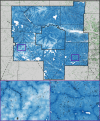Correlative ecological niche model applications to predicting landscape-scale woody plant encroachment in Kansas tallgrass prairie systems
- PMID: 38870187
- PMCID: PMC11175484
- DOI: 10.1371/journal.pone.0305168
Correlative ecological niche model applications to predicting landscape-scale woody plant encroachment in Kansas tallgrass prairie systems
Abstract
Woody plant encroachment (WPE) in grassland ecosystems has been a pervasive process across the Great Plains, yet a predictive understanding of where it will occur has been elusive. As an exploration of tools of potential utility in this challenge, we mapped WPE processes over the years 2015-2021 in a set of 9 counties in central Kansas. We developed and tested two correlative models based on landscape features: one that assessed distribution of evergreen trees in 2015, and another that assessed areas of WPE in succeeding years. Both models were successful, being able to predict 2015 forest distributions and being able to predict WPE during 2015-2021, as functions of characteristics of landscapes. These simple, correlative models will certainly not be able to predict WPE processes globally, or even regionally, but provide first proof-of-concept explorations for the central Great Plains region.
Copyright: © 2024 Peterson et al. This is an open access article distributed under the terms of the Creative Commons Attribution License, which permits unrestricted use, distribution, and reproduction in any medium, provided the original author and source are credited.
Conflict of interest statement
The authors have declared that no competing interests exist.
Figures






Similar articles
-
Woody plant encroachment, and its removal, impact bacterial and fungal communities across stream and terrestrial habitats in a tallgrass prairie ecosystem.FEMS Microbiol Ecol. 2015 Oct;91(10):fiv109. doi: 10.1093/femsec/fiv109. Epub 2015 Sep 6. FEMS Microbiol Ecol. 2015. PMID: 26347079
-
Fire and grazing influences on rates of riparian woody plant expansion along grassland streams.PLoS One. 2014 Sep 5;9(9):e106922. doi: 10.1371/journal.pone.0106922. eCollection 2014. PLoS One. 2014. PMID: 25192194 Free PMC article.
-
The long shadow of woody encroachment: An integrated approach to modeling grassland songbird habitat.Ecol Appl. 2024 Apr;34(3):e2954. doi: 10.1002/eap.2954. Epub 2024 Feb 21. Ecol Appl. 2024. PMID: 38379458
-
Determinants of woody encroachment and cover in African savannas.Oecologia. 2017 Apr;183(4):939-951. doi: 10.1007/s00442-017-3807-6. Epub 2017 Jan 23. Oecologia. 2017. PMID: 28116524 Free PMC article. Review.
-
Causes and consequences of woody plant encroachment into western North American grasslands.J Environ Manage. 2009 Jul;90(10):2931-42. doi: 10.1016/j.jenvman.2009.04.023. Epub 2009 Jun 5. J Environ Manage. 2009. PMID: 19501450 Review.
References
-
- Knapp AK, McCarron JK, Silletti AM, Hoch GA, Heisler JC, Lett MS, et al.. Ecological consequences of the replacement of native grassland by Juniperus virginiana and other woody plants. In: Van Auken OW, editor. Western North American Juniperus Communities. New York: Springer; 2008. p. 156–69.
-
- Huxman TE, Wilcox BP, Breshears DD, Scott RL, Snyder KA, Small EE, et al.. Ecohydrological implications of woody plant encroachment. Ecology. 2005;86:308–19.
-
- Acharya BS, Kharel G, Zou CB, Wilcox BP, Halihan T. Woody plant encroachment impacts on groundwater recharge: A review. Water. 2018;10:1466.
-
- Scholtz R, Polo JA, Fuhlendorf SD, Engle DM, Weir JR. Woody plant encroachment mitigated differentially by fire and herbicide. Rangeland Ecology & Management. 2018;71(2):239–44.
-
- Ganguli AC, Engle DM, Mayer PM, Hellgren EC. Plant community diversity and composition provide little resistance to Juniperus encroachment. Botany. 2008;86:1416–26.
MeSH terms
LinkOut - more resources
Full Text Sources
Research Materials

